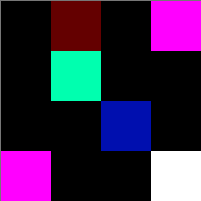Assignment 4: Image conscious
Due Friday, October 31st, before midnight
The goals for this assignment are:
-
Work with ascii and binary files
-
Understand binary representations of data types
-
Directly manipulate basic types at the bit level
-
Work with bitwise operators: |, &, ~, ^
This is a two-week assignment with two parts:
-
Part 1 (PPM): You will implement methods for reading and writing images in PPM format
-
Part 2 (Steganography): You will hide secret messages inside PPM images, a process called Steganography, in which information is hidden inside another message or object.
Update your repository
We will use the same repository as Assignment 1
First, you must accept the pull request on your repository on Github (screenshot).
$ cd cs223-f25-classwork
$ git pullYour repository should now contain a new folder named A04-Steganography.
PPM
-
You must check-in during office hours to show you have started this assignment on either Thursday October 23rd or Friday October 24th**
Implement two functions, read_ppm and write_ppm, that read and write binary PPM files.
This functions are implemented in the file ppm.c and tested using code in test_read.c and test_write.c.
Images are 2D arrays of pixels. In the following section, we give details on how PPM stores images as a 2D array.
| You can choose whether you load the array as either a single block of memory or as an array or arrays. Your basecode has function signatures for each. Choose one of the function signatures to implement. DO NOT remove the other function signatures! Don’t change the headers in anyway. |
Background
PPM (Portable Pix Map) is an image file format that stores the colors of an image as a 2D array of colors. Each color is represented as a RGB triplet, representing red, green and blue respectively. The properties of the image, such as its size and color format, are specified at the start of the file (called its "header information"). PPM supports both ASCII (plain text) and binary data (raw).
| We will write a function that reads PPM files in binary format! |
For example, consider the following image

The above image contains a 4x4 grid of colored pixels. Each pixel is a triplet of red-blue-green (RGB) color
values, each stored as an unsigned char. Unsigned chars have values which range from 0 to 255, where
smaller values correspond to darker colors. The triplet (0,0,0) corresponds to black. The triplet
(255,255,255) corresponds to white. The triplet (255,0,0) corresponds to red. This system of colors is called
the RGB Color Model and it is a common standard for
representing colors on a computer.
The RGB colors for the pixels in the above image are as follows
(0,0,0) (100,0,0) (0,0,0) (255,0,255)
(0,0,0) (0,255,175) (0,0,0) (0,0,0)
(0,0,0) (0,0,0) (0,15,175) (0,0,0)
(255,0,255) (0,0,0) (0,0,0) (255,255,255)In binary format (also called raw format), the image is stored as follows.
To see for yourself, do hexedit feep-raw.ppm.
00000000 50 36 0A 23 20 43 72 65 61 74 65 64 20 62 79 20 47 49 4D 50 20 76 65 72 P6.# Created by GIMP ver
00000018 73 69 6F 6E 20 32 2E 31 30 2E 32 34 20 50 4E 4D 20 70 6C 75 67 2D 69 6E sion 2.10.24 PNM plug-in
00000030 0A 34 20 34 0A 32 35 35 0A 00 00 00 64 00 00 00 00 00 FF 00 FF 00 00 00 .4 4.255....d...........
00000048 00 FF AF 00 00 00 00 00 00 00 00 00 00 00 00 00 0F AF 00 00 00 FF 00 FF ........................
00000060 00 00 00 00 00 00 FF FF FF .........The leftmost column is byte number in hexadecimal. For example, 0x18 is 24 in decimal. There are 24 bytes
on the first row on output. The rightmost column displays the raw data in ASCII, using . for non-visible
ASCII codes, such as '\0' and 'Escape'.
Regardless of format, every PPM file contains the following information.
-
A "magic number" indicating the type of PPM. Binary files start with "P6". ASCII files start with P3.
-
Whitespace (blanks, tabs, \n, \r, etc)
-
An optional comment. Comments must be on their own line and start with the symbol
#. -
Width and height as ASCII decimal integers (separated by whitespace)
-
Maximum color value as an ASCII decimal integer. You can assume the Maxval is less than 256, meaning each RGB value is 1 byte.
-
A single whitespace character
-
A raster (e.g. the array of pixels) of Height number of rows and Width number of columns, in order from top to bottom.
| The header information is always in plain text — regardless of whether the raster data is in ASCII or binary format. It is only the pixel data that differs between ASCII and raw formats. |
| PPM files can be viewed using tools such as eog (UNIX image viewer called Eye of Gnome) and Gimp. |
===
Read PPM
For this question, you will implement a function, read_ppm(), that can read
PPM files stored in binary format. This function should take a filename as input
and return a 2D array of struct pixel. A struct pixel has the following definition
struct ppm_pixel {
unsigned char red;
unsigned char green;
unsigned char blue;
};The caller of the function read_ppm is responsible for freeing the memory allocated by this function.
You will re-use this function throughout the semester. For this reason, we place its implementation
in it’s own file, read_ppm.c, and use a header file, read_ppm.h, to include it in our main application.
You may implement your 2D array of pixels as either a flat array or an array of arrays. For example, if you return a flat array, you should implement the following function.
// filename is the image PPM to open and read
// width (passed by pointer): container for the width of the image
// height (passed by pointer): container for the height of the image
// returns an array of ppm_pixel with size = width * height
struct ppm_pixel* read_ppm(const char* filename, int* width, int* height)If you return an array or arrays, you should implement the following function.
// filename is the image PPM to open and read
// width (passed by pointer): container for the width of the image
// height (passed by pointer): container for the height of the image
// returns an array of arrays of ppm_pixel with dimensions = (width, height)
struct ppm_pixel** read_ppm_2d(const char* filename, int* width, int* height)
The parameters width and height will contain the width and height of the image, after the image is loaded.
|
Run the file, test_ppm.c, to test your functions.
$ make test_read
gcc -g -Wall -Wvla -Werror test_read.c read_ppm.c -o test_read
$ ./test_read images/feep-raw.ppm
Testing file images/feep-raw.ppm: 4 4
(0,0,0) (100,0,0) (0,0,0) (255,0,255)
(0,0,0) (0,255,175) (0,0,0) (0,0,0)
(0,0,0) (0,0,0) (0,15,175) (0,0,0)
(255,0,255) (0,0,0) (0,0,0) (255,255,255)Requirements/Hints:
-
Your function should return NULL if the filename is invalid
-
Your function should return NULL if memory cannot be allocated for the image data
-
You can assume that it is safe to read the header line by line (e.g. using
fgets). -
Do not modify
read_ppm.horwrite_ppm.h. And do not remove the stubs for the functions you do not implement! -
Make sure your program compiles using the Makefile
-
Make sure you can load files with and without comments.
-
Make sure you can load either ASCII or binary PPM files.
Write PPM
Now implement a function to write PPM files in binary format.
Similarly to reading, you should choose one definition of write_ppm to
implement, depending on whether you use either a "flat array" or an "array of arrays" to store your pixels.
For example, if you use a flat array, you should implement the following function.
// filename is the image PPM to open and write
// data (passed by pointer): array of pixels
// width (passed by value): the width of the image
// height (passed by value): the height of the image
void write_ppm(const char* filename, struct ppm_pixel* data, int width, int height)If you use an array or arrays, you should implement the following function.
// filename is the image PPM to open and write
// data (passed by pointer): array of pixels
// width (passed by value): the width of the image
// height (passed by value): the height of the image
void write_ppm_2d(const char* filename, struct ppm_pixel** data, int width, int height)Use the file, test_write.c, to test your functions. For example,
$ make test_write
gcc -g -Wall -Wvla -Werror test_write.c write_ppm.c read_ppm.c -o test_write
$ ./test_write
Writing files test.ppm and test_2d.ppm with dimensions: 4 3
$ xxd test.ppm
00000000: 5036 0a33 2034 0a32 3535 0a00 0000 3232 P6.3 4.255....22
00000010: 3264 6464 0000 0032 3232 6464 6400 0000 2ddd...222ddd...
00000020: 3232 3264 6464 0000 0032 3232 6464 64 222ddd...222dddRequirements/Hints:
-
You can use
fwriteto write text for the header. Simply create a string and callfwrite(mystring, strlen(mystring), sizeof(char), fp); -
The header information should include the correct format ID (P6), the image width, the image height, and 255 for the maximum color value.
-
Do not modify write_ppm.h. And do not remove the versions of the function you do not implement!
-
Make sure your program compiles using the Makefile.
-
Test for memory leaks with valgrind!
Steganography
Steganography is the process of hiding messages within another message. With this question, you will hide text inside images.
Background
Credit: Chris Trailie (Original)
To understand how we will hide messages in the least significant bits of an image, let’s look at the following write-up by Chris Trailie, starting with the two pictures below.
Ordinary image |
Hidden message |

|

|
The picture on the right contains 12 paragraphs of text on the Ursinus 150 strategic plan. Can you see the difference? No? Well great, that's the point!
So how do we do this? The idea is beautifully simple, and is best understood with an example. Consider the following 3-pixel image
| [254, 119, 50] | [2, 141, 254] | [91, 159, 64] |
We're going to extract a binary signal by looking at the least significant bit (the 1's place in binary) of each color channel in each pixel from left to right from red, to green, to blue, and put them together into one binary string. In other words, for a particular pixel and a particular color channel, we'll extract a 0 if it's an even number and a 1 if it's an odd number. Let's look at the first 8 bits in the above image. We have
| 254 | 0 |
| 119 | 1 |
| 50 | 0 |
| 2 | 0 |
| 141 | 1 |
| 254 | 0 |
| 91 | 1 |
| 159 | 1 |
All together, this is the binary string 01001011, which is the character 'K' in ASCII. What if we wanted to change it to some other character though? Perhaps the character 'z', which is 0x7A hex, or 01111010 in binary. Then we can just tweak the 1's place of the pixel values as follows, where I've bolded the ones that have changed:
| 254 | 0 |
| 119 | 1 |
| 51 | 1 |
| 3 | 1 |
| 141 | 1 |
| 254 | 0 |
| 91 | 1 |
| 158 | 0 |
Here's what these updated values look like
| [254, 119, 51] | [3, 141, 254] | [91, 158, 64] |
If you were just looking at it and comparing it to what we started with, you would never notice the difference! So we have freedom to tweak the least significant bit of every color channel of every pixel at will to encode text, and this is exactly what you will be doing in this assignment!. In a 500x500 image, for example, this means we can store 250,000 bits. Since each ASCII character is 8 bits, this is 31,250 characters total, or roughly about 6000 words.
Decode
In the file, decode.c, write a program that reads in a PPM file (raw, or binary, format) and then outputs any message that might be stored in
the least significant bits of each color. Your program should read bits from each of the red, green, and blue colors — top to bottom, left to right.
You should keep decoding until you reach the empty character \0.
For example, consider the example file tiny_encoded.ppm. Decoding should give you the bits 001100010011011100110100001000010000101000000000.
If we group them up into ASCII char variables, we see this is the character string 174!\n.
| 00110001 | '1' |
| 00110111 | '7' |
| 00110100 | '4' |
| 00100001 | '!' |
| 00001010 | '\n' |
| 00000000 | '\0' |
Your program should perform as follows.
$ ./decode images/tiny_encoded.ppm
Reading tiny_encoded.ppm with width 4 and height 4
Max number of characters in the image: 6
174!
$ ./decode images/monalisa_encoded.ppm
Reading images/monalisa_encoded.ppm with width 606 and height 771
Max number of characters in the image: 175209
...secret message..
$ ./decode images/cats_encoded.ppm
...etc...Requirements/Hints:
-
You should read the PPM filename as a command line argument
-
You should report the usage if no file is given to the program
-
You should report an error if the file cannot be read
-
Re-use your implementation of
read_ppmandwrite_ppm -
Output the size of the image along with the maximum number of characters it can store
-
For debugging, try printing out values in hex format, e.g.
printf("%02X", c); -
This program is easier to implement if you use a 1D array because you can cast the
struct ppm_pixel*array to anunsigned char*array.
Encode
In the file, encode.c, write a program that reads in a PPM file (raw, or binary, format) and
asks the user for a message to embed within it.
$ make encode
gcc -g -Wall -Wvla -Werror encode.c read_ppm.c -o encode
$ ./encode images/feep_raw.ppm
Reading feep_raw.ppm with width 4 and height 4
Max number of characters in the image: 5
Enter a phrase: lol
Writing file feep_raw_encoded.ppmRequirements/Hints:
-
You should read the PPM filename as a command line argument
-
You should report the usage if no file is given to the program
-
You should report an error if the file cannot be read
-
You should output a new file based on the input name. For example, if the input is
feep_raw.ppm, the new file with the encoded message should befeep_raw_encoded.ppm. -
Re-use your implementation of
read_ppm. -
Output the size of the image along with the maximum number of characters it can store
-
For debugging, remember you can print values in hex format, e.g.
printf("%02X", c);
Grading Rubric
Assignment rubrics
Grades are out of 4 points.
Code rubrics
-
Code checkins
-
PPM read/write
-
Decode
-
Encode
For full credit, your C programs must be feature-complete, robust (e.g. run without memory errors or crashing) and have good style.
-
Some credit lost for missing features or bugs, depending on severity of error
-
-12.5% for style errors. See the class coding style here.
-
-50% for memory errors
-
-100% for failure to checkin work to Github
-
-100% for failure to compile on linux using make